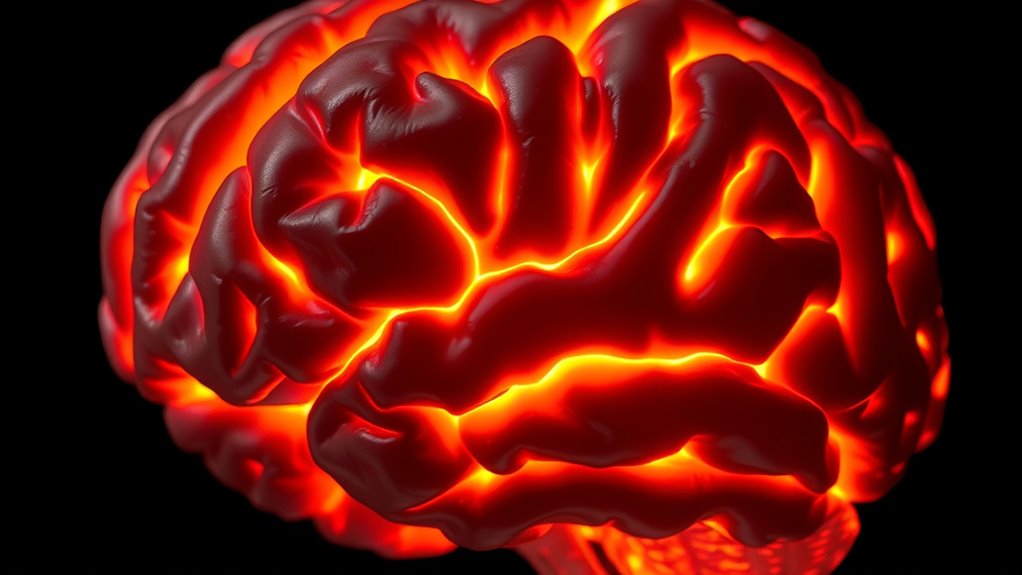The causes of BPD involve a mix of genetic factors, brain structure differences, and early adverse experiences. If someone in your family has traits like emotional dysregulation or impulsivity, your risk increases. Brain chemistry imbalances and structural differences, especially in areas controlling emotions and impulses, also play a role. Childhood trauma or neglect further heighten vulnerability. To understand how these factors interact and affect you, keep exploring this complex condition.
Key Takeaways
- Genetic factors and family history increase susceptibility to BPD through inherited traits and complex gene-environment interactions.
- Neurochemical imbalances, such as serotonin and dopamine disruptions, impair emotion regulation and impulsivity control.
- Structural brain differences, including amygdala and prefrontal cortex abnormalities, affect emotional processing and impulse management.
- Childhood trauma, neglect, and invalidating environments disrupt normal brain development and emotional regulation skills.
- Environmental stressors like abuse, family instability, and long-term adversity contribute to emotional dysregulation associated with BPD.
Genetic Influences and Family History

Genetic influences and family history play a significant role in the development of Borderline Personality Disorder (BPD). If you have a family history of BPD, you’re at a higher risk of developing it yourself, highlighting the importance of genetic factors and heritability. Twin studies show that identical twins are more likely to both have BPD compared to fraternal twins, indicating a genetic contribution. Many family members of individuals with BPD display traits like emotional dysregulation and impulsivity, supporting inherited predispositions. Additionally, the heritability estimate for BPD suggests a substantial genetic component. Research on genetic heritability underscores that genetic factors can account for a significant portion of the risk. Moreover, advancements in genetic research continue to shed light on the complex interplay between inherited traits and environmental influences. Understanding the neurobiological factors involved in BPD can help clarify how brain structure and function contribute to emotional regulation difficulties. These findings highlight the importance of considering both genetic and environmental influences in understanding BPD development. However, genetics alone don’t determine BPD; environmental factors, such as trauma, also influence susceptibility. Your genetic makeup can increase vulnerability, but it’s the interaction with environmental influences that ultimately shapes BPD development.
Neurochemical Imbalances in the Brain

Neurochemical imbalances in the brain play a crucial role in the development of Borderline Personality Disorder (BPD). Altered serotonin levels are common and linked to symptoms like impulsivity, depression, and aggression.
Neurotransmitter imbalances, including irregularities in dopamine and norepinephrine, contribute to emotional instability and impulsive behaviors. These imbalances can also affect brain connectivity and overall mental health. Recognizing patterns of angel number soulmate may help in understanding emotional triggers and relationship dynamics. Additionally, research shows that neurochemical abnormalities can influence relationship patterns, which are often observed in individuals with BPD.
Disruptions in brain regions responsible for emotion regulation, such as the amygdala and prefrontal cortex, are associated with neurochemical abnormalities. These neurochemical disruptions can impair mood stability and impulse control.
Specifically, chemical imbalances in serotonergic systems affect emotional responses, while neurotransmitter imbalances influence brain region functioning. Understanding these neurochemical abnormalities helps explain the emotional and behavioral challenges faced by individuals with BPD.
- Altered serotonin levels impact mood and impulsivity
- Neurotransmitter imbalances involve dopamine and norepinephrine
- Brain regions like the amygdala and prefrontal cortex are affected
- Neurochemical disruptions influence emotional regulation
- Neurochemical abnormalities can also impact brain connectivity and overall mental health.
Brain Development and Structural Differences

Brain development and structural differences play a significant role in Borderline Personality Disorder by affecting how emotional and impulsive behaviors are managed. MRI studies reveal that individuals with BPD often have a smaller or abnormally active amygdala, which disrupts emotion regulation.
Structural differences in the hippocampus, a key area for self-control, are also common, impairing behavior regulation. The orbitofrontal cortex, responsible for decision-making and impulse control, may be underdeveloped or functionally altered, further contributing to impulsivity.
These brain structure variations lead to altered brain connectivity between emotion regulation centers and impulse control regions. Together, these differences in brain development and structure underlie the emotional instability and impulsiveness characteristic of BPD.
Impact of Childhood Trauma and Neglect

Childhood trauma and neglect markedly increase the risk of developing Borderline Personality Disorder by shaping how your brain processes emotions and stress. Traumatic experiences and emotional deprivation during early life can disrupt normal brain development, especially in areas responsible for emotion regulation like the amygdala and hippocampus.
These disruptions make you more stress-sensitive and prone to emotional instability. Neglect and invalidating environments often lead to maladaptive coping strategies, as you struggle to manage intense feelings.
- Childhood trauma, including abuse, significantly influences BPD risk
- Neglect causes emotional deprivation, affecting self-identity
- Traumatic experiences impair brain regions involved in emotion regulation
- These early life factors heighten stress sensitivity and emotional dysregulation
Environmental Stressors and Life Experiences

Environmental stressors and challenging life experiences play a significant role in the development of BPD, especially when they occur during sensitive periods. Childhood abuse, neglect, and invalidating environments disrupt emotional regulation and increase vulnerability.
Environmental stressors during childhood can profoundly impact emotional regulation and vulnerability.
Traumatic events like physical, sexual, or emotional abuse further heighten the risk. Growing up in an unstable family with long-term stressors—such as parental substance misuse or mental health issues—can create chaos that worsens emotional stability. Additionally, inconsistent caregiving can impair secure attachment formation. The importance of cultural heritage in fostering resilience and emotional well-being can be overlooked but is vital in understanding individual responses to trauma.
The loss of a caregiver or witnessing violence deeply impacts emotional development. These environmental stressors interact with biological factors, like genetics, to shape BPD risk. Environmental factors such as family dynamics and community influences can further complicate emotional development. Furthermore, ongoing exposure to adverse childhood experiences can have cumulative effects that influence emotional regulation well into adulthood. Recognizing the biological and environmental interplay helps in understanding the multifaceted origins of BPD.
Experiencing these adverse circumstances during formative years can leave lasting effects, influencing how you manage emotions and form relationships later in life. Additionally, exposure to environmental stressors such as economic hardship or community violence can exacerbate emotional dysregulation associated with BPD. Recognizing the interplay between these factors is crucial for developing effective support and intervention strategies.
Frequently Asked Questions
What Is the Main Causes of BPD?
The main causes of BPD involve a mix of genetic factors and environmental influences. You might have a family history of mental health issues, which increases your risk.
Childhood trauma, like abuse or neglect, profoundly impacts development.
Additionally, brain differences affecting emotion regulation can contribute.
Stressful life events, especially early in life, can trigger or worsen symptoms.
Recognizing these causes helps you understand why BPD develops and guides effective treatment approaches.
What Are the Main Triggers of BPD?
You might wonder what triggers BPD symptoms. Stressful or traumatic events, such as childhood abuse or neglect, often activate these symptoms.
Losing a loved one or experiencing abandonment can also be significant triggers.
Ongoing family conflicts or witnessing violence create an unstable environment, making you more vulnerable.
Even adult traumas like accidents or assaults can worsen BPD symptoms if you’re predisposed.
Recognizing these triggers helps you better understand and manage your condition.
What Is the Life Expectancy of a Person With BPD?
Imagine you’re walking a tightrope over a canyon—your balance is fragile. People with BPD often face a slightly shorter life span, mainly due to risks like suicide and self-harm.
But with proper treatment and support, you can strengthen that balance. Addressing comorbid issues such as depression or substance abuse helps, too.
Early intervention and ongoing care are your safety nets, helping you stay steady and extend your journey across the canyon.
What Kind of Trauma Causes BPD?
You might wonder what kind of trauma leads to BPD. It often stems from childhood experiences like sexual, physical, or emotional abuse, or neglect.
Witnessing family violence or experiencing significant loss, such as a parent’s death, can also contribute. Growing up in unstable or invalidating environments, where your feelings aren’t acknowledged or understood, increases the risk.
These traumatic experiences shape emotional regulation and relational patterns associated with BPD.
Conclusion
Remember, understanding the causes of BPD helps you see it’s a mix of genetics, brain differences, trauma, and stress. While it might feel overwhelming, knowledge is power—like the saying, “Forewarned is forearmed.” Recognizing these factors can guide you toward compassion, support, and effective treatment. You’re not alone in this journey, and with awareness, you can take steps to heal and find stability. Stay hopeful—change is possible.
Isla’s writings reflect a profound connection to the BPD community, offering solace and understanding to those who feel isolated by their struggles. Her articles explore the nuances of relationships, healing, and self-discovery, all through the lens of BPD. Isla’s compassionate approach to storytelling encourages readers to embrace their journey with hope and resilience.










